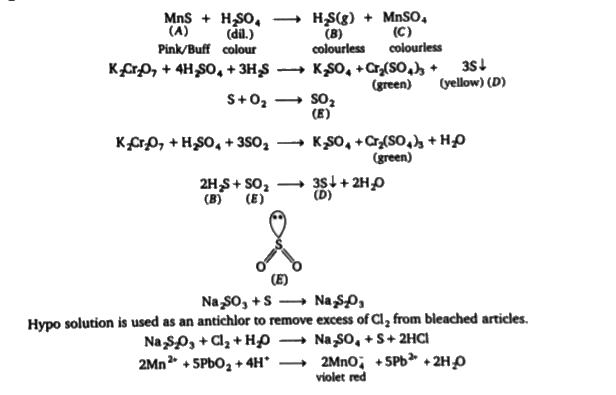A coloured compound (A) reacts with dilute H2SO4 to produce a colourless gas (B) and colourless solution (C). The reaction between (B) and the acidified K2Cr2O7 solution produces a green solution and a slightly yellowish precipitate (D). the substance (D) burns in air to produce a gas (E) which also cann change the colour of K2Cr2O7 solution.
Q. When D is boiled with alkaline sulphite solution a compound F is formed. F can be used in
(I) Iodine titrations in volumetric analysis
(II) Bleaching industry to destroy excess Cl2
(III) Photography for 'fixing' films
(IV) Iodometric titrations
Choose the correct codes:
I and IV
I, III and IV
II and III
I, II, III and IV
The correct Answer is:D
Topper's Solved these Questions
- QUALITATIVE INORGANIC ANALYSISBook:VK JAISWALChapter:QUALITATIVE INORGANIC ANALYSISExercise:ONE OR MORE ANSWER IS/ARE CORRECT
Explore 45 Videos
- QUALITATIVE INORGANIC ANALYSISBook:VK JAISWALChapter:QUALITATIVE INORGANIC ANALYSISExercise:MATCH THE COLUMN
Explore 2 Videos
- QUALITATIVE INORGANIC ANALYSISBook:VK JAISWALChapter:QUALITATIVE INORGANIC ANALYSISExercise:LEVEL 2
Explore 75 Videos
- PERIODIC PROPERTIESBook:VK JAISWALChapter:PERIODIC PROPERTIESExercise:ASSERTION-REASON TYPE QUESTIONS
Explore 35 Videos
- s-BLOCK ELEMENTSBook:VK JAISWALChapter:s-BLOCK ELEMENTSExercise:SUBJECTIVE PROBLEMS
Explore 2 Videos
Similar Questions
When H2S is passed through acidified K2Cr2O7 solution, the solution turns :
View SolutionA coloured compound (A) reacts with dilute H2SO4 to produce a colourless gas (B) and colourless solution (C). The reaction between (B) and the acidified K2Cr2O7 solution produces a green solution and a slightly yellowise precipitate (D). the substance (D) burns in air to produce a gas (E) which also can change the colour of K2Cr2O7 solution.
Q. "A" probably, is
View Solution
Knowledge Check
A coloured compound (A) reacts with dilute H2SO4 to produce a colourless gas (B) and colourless solution (C). The reaction between (B) and the acidified K2Cr2O7 solution produces a green solution and a slightly yellowish precipitate (D). the substance (D) burns in air to produce a gas (E) which also cann change the colour of K2Cr2O7 solution.
Q. "A" probably, is:AZnSO3BCoSCMnSDNiSA coloured compound (A) reacts with dilute H2SO4 to produce a colourless gas (B) and colourless solution (C). The reaction between (B) and the acidified K2Cr2O7 solution produces a green solution and a slightly yellowish precipitate (D). the substance (D) burns in air to produce a gas (E) which also cann change the colour of K2Cr2O7 solution.
Q. When "B" racts with "E":Aa new gas F will be producedBIt produced D and a colourless liquidCthere will be no reaction between themDit yields B and an acidic oxieA coloured compound (A) reacts with dilute H2SO4 to produce a colourless gas (B) and colourless solution (C). The reaction between (B) and the acidified K2Cr2O7 solution produces a green solution and a slightly yellowise precipitate (D). the substance (D) burns in air to produce a gas (E) which also can change the colour of K2Cr2O7 solution.
Q. When "B" reacts with "E"AA new gas F will be producedBIt produces D and a colourless liquidCThere will be no reaction between themDIt yields B and an acidic oxide
A coloured compound (A) reacts with dilute H2SO4 to produce a colourless gas (B) and colourless solution (C). The reaction between (B) and the acidified K2Cr2O7 solution produces a green solution and a slightly yellowish precipitate (D). the substance (D) burns in air to produce a gas (E) which also cann change the colour of K2Cr2O7 solution.
Q. Which is not correct about E ?
View SolutionA coloured compound (A) reacts with dilute H2SO4 to produce a colourless gas (B) and colourless solution (C). The reaction between (B) and the acidified K2Cr2O7 solution produces a green solution and a slightly yellowise precipitate (D). the substance (D) burns in air to produce a gas (E) which also can change the colour of K2Cr2O7 solution.
Q. Which is not correct about E
View SolutionA coloured compound (A) reacts with dilute H2SO4 to produce a colourless gas (B) and colourless solution (C). The reaction between (B) and the acidified K2Cr2O7 solution produces a green solution and a slightly yellowish precipitate (D). the substance (D) burns in air to produce a gas (E) which also cann change the colour of K2Cr2O7 solution.
Q. When colourless solution (C) reacts with Pb3O4/H+, it acquries a violet red colour due to formation of :
View SolutionA coloured compound (A) reacts with dilute H2SO4 to produce a colourless gas (B) and colourless solution (C). The reaction between (B) and the acidified K2Cr2O7 solution produces a green solution and a slightly yellowise precipitate (D). the substance (D) burns in air to produce a gas (E) which also can change the colour of K2Cr2O7 solution.
Q. When colourless solution (C) reacts with Pb3O4/H+, it acquires a violet red colour due to formation of
View SolutionA white substance (A) reacts with dilute H2SO4 to produce a colourless gas (B) and a colourless solution (C). The reaction between (B) and acidified K2Cr2O7 solution produces a green solution and a slightly coloured precipitate (D). Addition of aqueous ammonia or sodium hydroxide to (C) produces first a precipitate, which dissolves in the excess of teh respective reagent to produce a clear solution in each case.
The colourless gas (B) is:
View Solution

